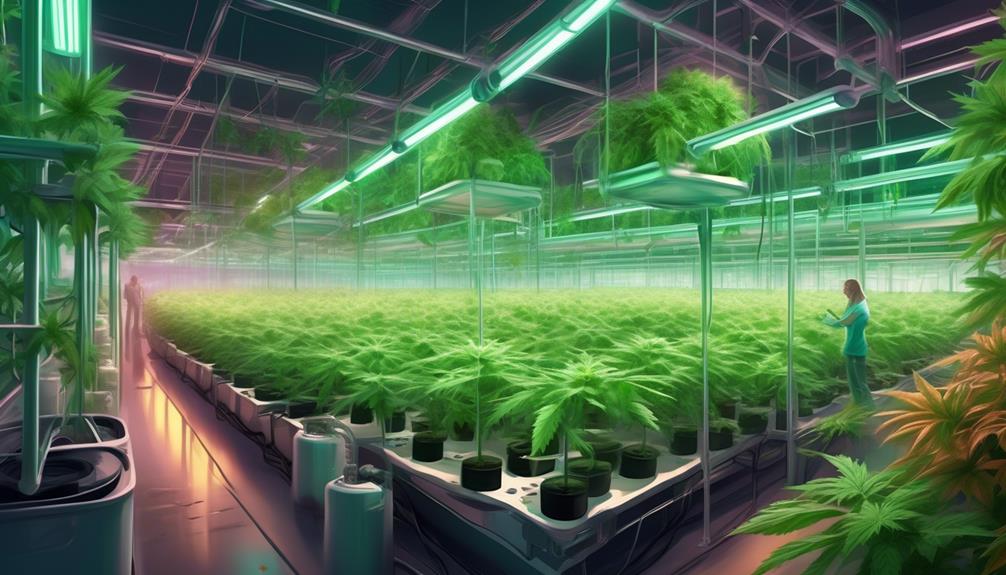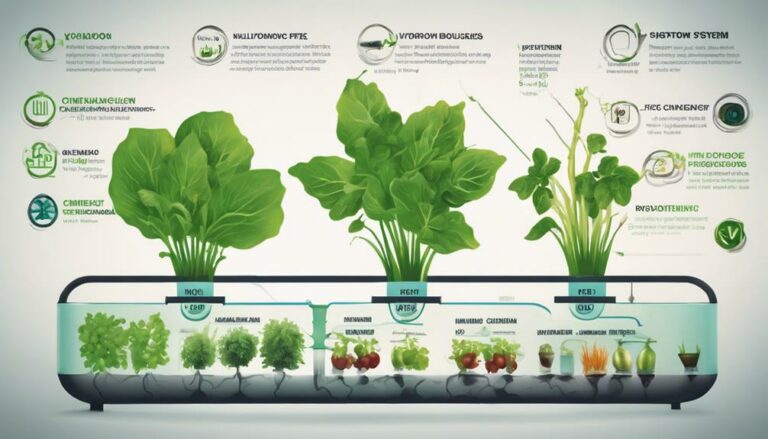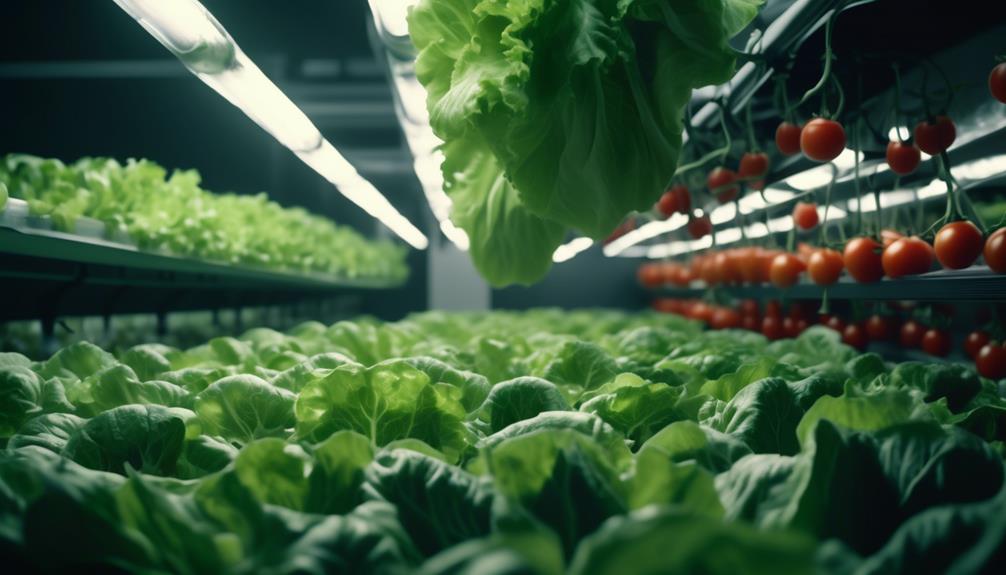As the commercial cannabis industry continues to mature, cultivators are perpetually in search of methods to enhance productivity and profitability, while simultaneously addressing sustainability concerns.
Table of Contents
Hydroponic systems have emerged as a formidable solution, offering several compelling advantages over traditional soil-based cultivation. These systems facilitate precise control over the growing environment, including nutrient management and pH levels, leading to improved growth rates and consistent quality.
Additionally, the recirculation of water within hydroponic setups significantly reduces consumption, aligning with environmental conservation efforts. The space-efficient nature of these systems also presents an opportunity for maximizing yield in limited areas, a critical consideration for urban cultivators.
Yet, the transition to hydroponics is not without its complexities, involving a steep learning curve and initial infrastructure investment. It is imperative for stakeholders to consider the long-term implications of such a shift, examining the potential for increased yield and quality against the backdrop of operational adjustments and market demands.
Key Takeaways
- Enhanced growth rates and consistent quality control are key benefits of hydroponic systems for commercial cannabis cultivation.
- Hydroponic systems allow for space efficiency maximization and increased plant density, maximizing the potential for vertical growth.
- Integrated pest management strategies and the use of beneficial insects and biological controls are effective in managing pests and diseases in hydroponic cannabis cultivation.
- Hydroponic systems offer scalability, flexibility, and innovation, allowing for easy expansion, customization of system parameters, and integration of adaptive technologies for precision cultivation.
Enhanced Growth Rates
Hydroponic systems significantly ramp up the growth rates of cannabis by providing plants with precise nutrient delivery and optimal growth conditions. These systems have revolutionized cannabis cultivation, enabling cultivators to achieve faster growth and more efficient production cycles. By ensuring a direct supply of nutrient solution to the roots, hydroponic setups bypass the inconsistencies and limitations often associated with soil-based agriculture. This direct feeding strategy promotes accelerated plant development, as roots have immediate access to essential nutrients.
Controlled environments intrinsic to hydroponic systems are meticulously regulated, creating an ideal atmosphere that fosters rapid cannabis growth. Temperature, humidity, and light—the trifecta of plant growth—are fine-tuned to meet the specific requirements of the cannabis strain being cultivated. This precision not only bolsters growth rates but also contributes to uniformity and quality of the final product.
The elimination of soil from the equation further streamlines nutrient uptake, as the absence of soil-borne pests and pathogens results in a more sanitized root zone. Consequently, the plants can allocate more energy to vegetative growth and flowering, rather than to combating stressors. Hydroponic systems are not just a cultivation method; they represent an optimized environment for plant performance, delivering consistent and enhanced growth rates for cannabis.
Consistent Quality Control
Building upon the enhanced growth rates achieved through hydroponic systems, the ability to maintain consistent quality control becomes a pivotal advantage in commercial cannabis cultivation. These systems surpass traditional soil-based methods by providing precise and predictable nutrient delivery, essential for achieving higher quality yields. The Nutrient Film Technique (NFT), for instance, ensures a continuous flow of water and nutrients, enabling growers to maintain optimal nutrient levels with remarkable accuracy.
The hydroponic environment significantly reduces the risk of disease and pest infestations, which are often the bane of consistency in plant quality. By controlling these variables, cultivators can ensure a uniform and high-quality product, batch after batch. This level of control is particularly important for cannabis, where product consistency is vital for consumer trust and regulatory compliance.
Furthermore, the adoption of modern tools and technology in hydroponic setups has revolutionized the cultivation process. Growers can now monitor and adjust the variables affecting plant growth in real-time, adhering to the best practices that underpin consistent quality control. This innovative approach not only improves the standardization of the cannabis produced but also positions hydroponic systems at the forefront of sustainable and reliable commercial cultivation.
Space Efficiency Maximization
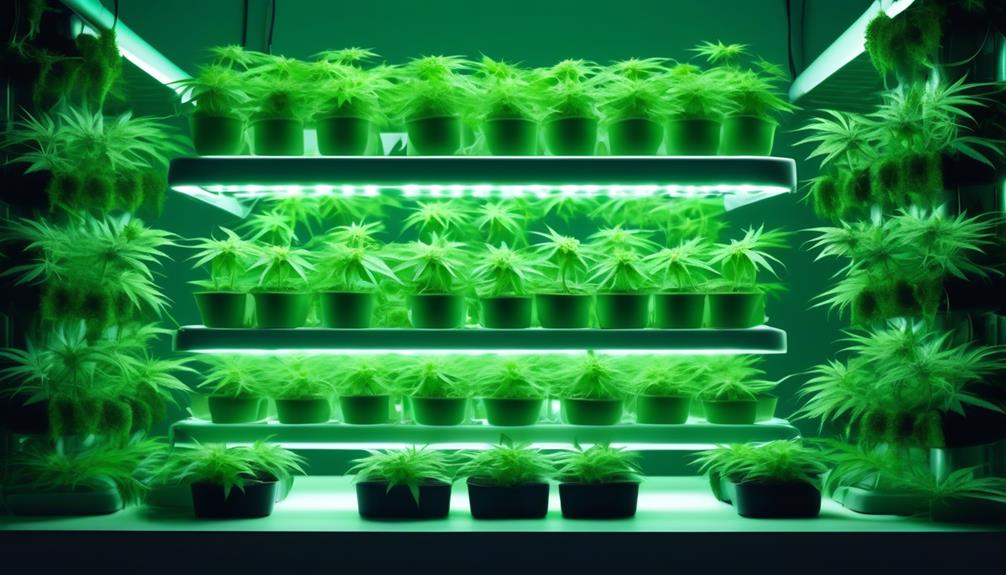
Hydroponic systems offer a strategic advantage in commercial cannabis cultivation by facilitating increased plant density through vertical growth configurations. This method not only enhances spatial utilization but also contributes to a significant uptick in production per unit area.
The potential for vertical expansion within these systems presents a compelling case for their adoption, particularly in urban settings where space is at a premium.
Increased Plant Density
Maximizing space efficiency, commercial cannabis cultivation has seen a significant shift towards utilizing increased plant density within hydroponic systems. This space-savvy approach is central to the value proposition of hydroponic cannabis operations, especially when employing methods such as Deep Water Culture.
Here is how increased plant density is achieved and why it matters:
- Space Efficiency
- More plants per section due to compact design
- Precision in plant placement optimizes square footage
- Densely packed plants without sacrificing health or yield
- Controlled Environment
- Consistent, efficient nutrient delivery
- Predictability in growth patterns facilitates closer spacing
- Yield Maximization
- Increased yield per square foot
- Enhanced turnover rates in commercial hydroponics
- Greater overall production within limited spaces
Vertical Growth Potential
While increased plant density within hydroponic systems has contributed to space efficiency, the adoption of vertical growth potential represents a further evolution in maximizing the use of available cultivation areas.
Vertical growth systems, by allowing the stacking of multiple growing layers, optimize the vertical real estate, which is particularly beneficial for indoor cannabis farms where horizontal space may be at a premium.
The implementation of such Growing Systems signifies a substantial increase in yield per square foot compared to traditional, single-layer cultivation. This innovative approach not only elevates the productivity of hydroponics but also minimizes the physical footprint required for large-scale cannabis operations.
Consequently, vertical growth potential in hydroponic frameworks is a game-changer for urban commercial cultivators aiming to amplify their output within confined spaces.
Water and Nutrient Usage
In commercial cannabis cultivation, the utilization of hydroponic systems markedly reduces water consumption by up to 90% compared to traditional soil farming, establishing a more sustainable model for resource management. This dramatic decrease in water usage is achieved through a closed-loop system where water is recirculated and precisely delivered to the plant roots.
- Precise Nutrient Management
- Nutrient solutions in hydroponics are tailored to the specific needs of cannabis plants, maximizing absorption and growth.
- Optimal ratios of essential elements are provided, preventing deficiencies and toxicities that can occur in soil.
- Adjustments to the nutrient mix are made in real-time based on plant feedback, reducing guesswork and increasing yields.
- Water Efficiency
- Direct delivery systems to plant roots minimize evaporation and runoff, conserving water.
- The recapture and reuse of water in hydroponic setups create less waste and lower water bills.
- Hydroponic systems maintain optimal hydration levels, avoiding both overwatering and underwatering.
- Environmental and Operational Benefits
- Lower maintenance and labor requirements due to automated and controlled feeding schedules.
- Less waste generation as nutrient solutions are used efficiently, reducing environmental impact.
- Scalability and adaptability of hydroponic systems allow for precise resource allocation, aligning with sustainable cultivation practices.
The strategic use of hydroponic technology in cannabis cultivation not only preserves vital resources but also enhances control over the growing environment, leading to robust, high-quality yields with a smaller ecological footprint.
Pest and Disease Management

Effective pest and disease management is pivotal in hydroponic cannabis cultivation, requiring vigilant monitoring and proactive strategies to ensure plant health and yield optimization. Hydroponic systems present unique benefits in this regard, primarily due to the reduced risk of soil-borne diseases and the streamlined ability to manage environmental factors.
By implementing integrated pest management (IPM) strategies, cultivators are able to monitor plant health closely, identifying and addressing potential issues before they escalate. This precise approach is complemented by the use of beneficial insects and biological controls, which are especially effective within the controlled conditions of hydroponic setups.
Moreover, the intrinsic cleanliness of hydroponic systems further aids in pest and disease management. The absence of soil minimizes the habitat for pests and the propagation of pathogens, thereby facilitating a more sterile growing environment. This sterility is crucial in preventing disease outbreaks, which can be catastrophic in densely populated commercial operations.
When infections do arise, the ability to quarantine and treat affected plants individually is an invaluable asset of hydroponics, preventing the spread of diseases and safeguarding the overall crop. This level of control and responsiveness is integral to the success of commercial cannabis cultivation in hydroponic systems.
Scalability and Flexibility
Hydroponic systems are inherently scalable and flexible, offering commercial cannabis cultivators the ability to efficiently expand and fine-tune their operations to meet evolving demands and production targets. The sophisticated nature of hydroponic grow setups allows for a dynamic approach to commercial cannabis cultivation, ensuring that producers can not only adapt to current market trends but also anticipate future shifts.
- Scalability:
- Easy Expansion: Modular components can be replicated to grow the operation.
- Space Optimization: Systems can be designed to maximize vertical and horizontal grow space.
- Strain and Growth Stage Tailoring: Adjustments can accommodate different cannabis strains or specific growth stages.
- Flexibility:
- Customization: System parameters can be tuned to the unique requirements of each crop.
- Adaptive Technologies: Incorporation of cutting-edge sensors and automation for precision cultivation.
- Resource Efficiency: Optimized water and nutrient delivery systems reduce waste.
- Innovation Integration:
- Technological Advances: Hydroponic systems support the use of AI and IoT for advanced analytics.
- Continuous Improvement: Feedback loops allow for ongoing refinement of cultivation techniques.
- Market Responsiveness: Quick adaptation to consumer preferences and regulatory changes.
Hydroponic grow systems provide commercial cannabis operations with the scalability and flexibility needed to remain competitive, productive, and innovative in a rapidly growing industry.
Year-Round Cultivation
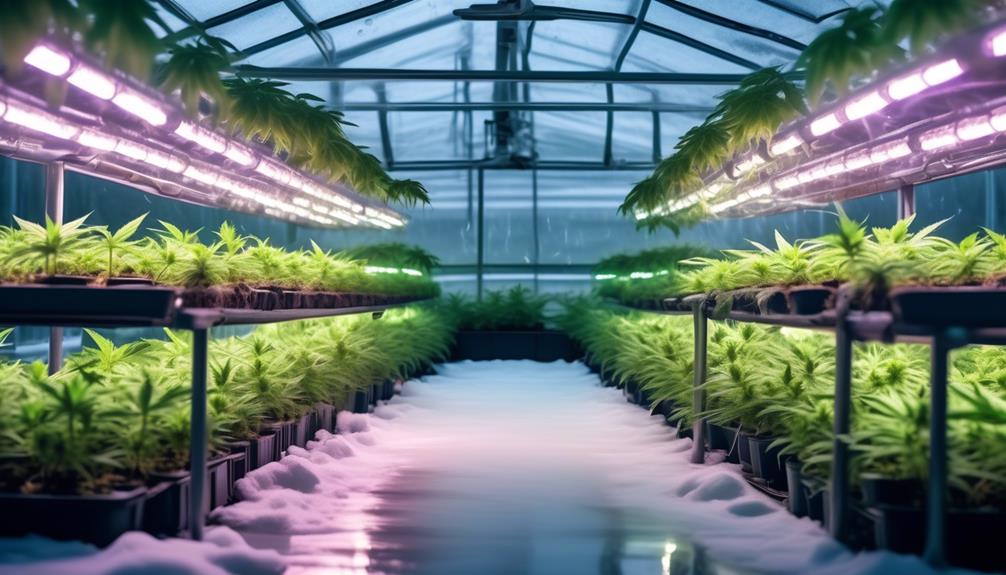
Building on the scalability and flexibility of hydroponic systems, commercial cannabis cultivators are empowered to achieve year-round cultivation, ensuring a continuous supply of crops regardless of external climatic conditions. This capacity for year-round cultivation is vital for meeting the persistent market demand and maintaining a consistent quality of produce.
Hydroponic systems provide unparalleled control over environmental conditions, which is indispensable for cannabis cultivation. This control facilitates the growth of cannabis plants in optimal conditions throughout the year, mitigating the unpredictable nature of seasons and weather. As a result, growers can predict harvest schedules with remarkable accuracy, which is paramount for planning and meeting the expectations of retailers and consumers.
The ability to cultivate cannabis year-round through hydroponic systems also maximizes the use of available growing space and resources. By eliminating the downtime associated with traditional soil-based growing cycles, hydroponic cultivation allows for the continuous use of infrastructure, leading to enhanced efficiency and increased profitability.
Furthermore, the predictability of year-round cultivation ensures that resources are allocated effectively, reducing waste and increasing the sustainability of the operation.
Environmental Impact Reduction
In the realm of commercial cannabis cultivation, adopting hydroponic systems plays a crucial role in significantly reducing the environmental footprint of farming operations. The precision and efficiency of hydroponics allow for noteworthy environmental impact reduction, which aligns with the increasing global demand for sustainable agricultural practices.
- Water Conservation:
- Uses up to 90% less water than soil cultivation.
- Closed-loop systems reclaim and reuse water, minimizing waste.
- Chemical Reduction:
- Requires less chemical pesticides and fertilizers due to controlled environments.
- Minimizes the risk of biological contamination, ensuring cleaner cultivation.
- Energy Efficiency:
- Supports energy-efficient practices through the controlled environment.
- Aligns with sustainable farming by optimizing resource usage and reducing waste.
Hydroponic systems’ ability to use less water and nutrients not only limits the depletion of these vital resources but also leads to a cascade of eco-friendly benefits. By necessitating fewer chemical inputs, hydroponics mitigates the potential for environmental contamination and promotes ecological balance. Furthermore, the recirculation of water embodies the principles of an economy that values resource circularity.
This strategic integration of hydroponics in cannabis cultivation represents a forward-thinking approach to agricultural innovation, one that is responsive to environmental imperatives and the pursuit of sustainability.
How Does Water Quality Affect Commercial Cannabis Cultivation in Hydroponic Systems?
The overall growth and yield of commercial cannabis cultivation in hydroponic systems heavily depend on water quality in hydroponics. Poor water quality can lead to nutrient imbalances, root diseases, and reduced plant health. Maintaining proper water quality in hydroponics is crucial for maximizing the potential of the cannabis plants.
Investment and Profitability
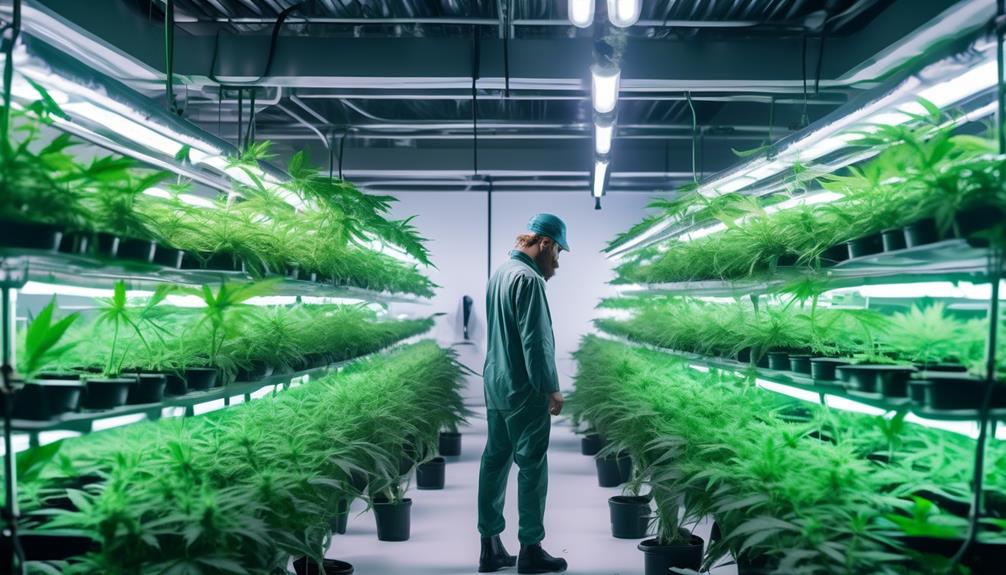
In evaluating the investment and profitability of hydroponic systems for commercial cannabis cultivation, it is essential to consider the balance between initial capital outlay and the potential for maximized yield returns.
The implementation of hydroponic technology can significantly reduce operational costs through savings on water, nutrients, and labor, while simultaneously enhancing yield quality and consistency.
An analytical review of cost-benefit dynamics reveals that the strategic application of hydroponic systems can lead to a more robust bottom line for cultivators navigating the competitive cannabis market.
Maximizing Yield Returns
Maximizing yield returns in commercial cannabis cultivation hinges on meticulously balancing initial investment with the strategic optimization of resources to enhance profitability. Hydroponics, with its controlled environment, plays a pivotal role in this delicate equation. By precisely managing the growth phase conditions, cultivators can push the boundaries of productivity and quality.
Resource Optimization:
- Nutrient Delivery: Tailoring nutrient mixtures for each growth phase to promote vigorous, healthy plants.
- Water Use: Circulating systems that conserve water and nutrients, significantly reducing waste.
- Space Efficiency: Vertical hydroponic systems maximize grow space, increasing yield per square foot.
The analytical approach in hydroponics allows for maximizing yield returns, making commercial cannabis cultivation not just viable but highly profitable for forward-thinking investors.
Reducing Operational Costs
Effective management of operational costs is crucial for enhancing the profitability of commercial cannabis cultivation through hydroponic systems. By investing in these systems, cultivators can achieve long-term cost savings due to the efficient utilization of water and nutrients, which are delivered with precision, minimizing waste.
The absence of soil eliminates a significant variable, reducing expenditures related to soil management and the mitigation of soil-borne diseases. Additionally, the controlled environment of a grow room facilitates the fine-tuning of conditions, which can decrease labor costs through automation and potentially reduce the use of pesticides due to a lower incidence of pests and diseases.
These factors combine to accelerate growth rates, increase yield, and improve the financial performance of hydroponic cannabis operations.
Frequently Asked Questions
Is Hydroponic Better for Cannabis?
Hydroponics can be superior for cannabis cultivation, offering significant water savings, precise nutrient control, enhanced root health, and accelerated growth speed, which are critical for maximizing efficiency and yield in innovative agricultural practices.
Which Hydroponic System Is Best for Commercial?
Determining the optimal hydroponic system for commercial use requires evaluating system scalability, nutrient control, space efficiency, and investment cost, with drip systems often providing a balance suitable for large-scale operations.
What Are the Advantages of Hydroponic Production?
Why settle for less when you can optimize growth? Hydroponic production excels with substantial water savings, meticulous nutrient control, remarkable space efficiency, and notably faster growth, epitomizing the pinnacle of agricultural innovation and sustainability.
Does Hydroponics Increase Yield Cannabis?
Hydroponics often increases cannabis yield through enhanced water savings, precise growth control, superior nutrient efficiency, and effective space optimization, presenting a sophisticated solution for cultivators prioritizing innovative, high-yield agricultural practices.
Conclusion
In conclusion, hydroponic systems present a compelling solution for commercial cannabis cultivation, offering enhanced growth rates and consistent quality.
The maximization of space efficiency, coupled with meticulous water and nutrient usage, fortifies the sustainability of these systems.
Effective pest and disease management, alongside the scalability and flexibility of hydroponics, supports continuous year-round production.
Collectively, these factors contribute to a reduction in environmental impact and bolster the potential for increased investment returns and profitability in the cannabis industry.

